| Listing 1 - 10 of 32 | << page >> |
Sort by
|
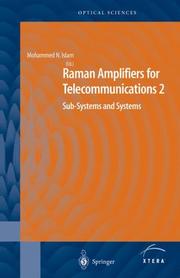
ISBN: 1280189312 9780387215859 9786610189311 0387406565 0387215859 Year: 2004 Publisher: New York, NY : Springer New York : Imprint: Springer,
Abstract | Keywords | Export | Availability | Bookmark
 Loading...
Loading...Choose an application
- Reference Manager
- EndNote
- RefWorks (Direct export to RefWorks)
I remember vividly the ?rst time that I heard about the ?ber ampli?er. At that time, of course, it was the erbium-doped ?ber ampli?er, the predecessor of the Raman ampli?er that is the subject of this book. It was an early morning in a forgotten year in Murray Hill, New Jersey at one of our Bell Labs monthly research staff meetings. About twenty directors and executive directors of research organizations clustered around a long table in the imposing executive conference room. Arno Penzias, the vice president of research, presided at the foot of the table. Everyone who participated in those research staff meetings will long remember their culture and atmosphere. Arno would pick an arbitrary starting point somewhere around the table, and the designated person would head to the front of the table to give a short talk on “something new” in his or her research area. This ?rst speaker would invariably ?ddle helplessly with the controls embedded in the podium that controlled the viewgraph projector, but eventually we would hear machinery grinding in the back room as a large hidden mirror moved into place. We would all wait quietly, arranging and choosing our own viewgraphs from the piles that lay on the table in front of every participant.
Fiber optics. --- Telecommunication. --- Microwaves. --- Communications Engineering, Networks. --- Optics, Lasers, Photonics, Optical Devices. --- Microwaves, RF and Optical Engineering. --- Hertzian waves --- Electric waves --- Electromagnetic waves --- Geomagnetic micropulsations --- Radio waves --- Shortwave radio --- Electric communication --- Mass communication --- Telecom --- Telecommunication industry --- Telecommunications --- Communication --- Information theory --- Telecommuting --- Electrical engineering. --- Lasers. --- Photonics. --- Optical engineering. --- Mechanical engineering --- New optics --- Optics --- Light amplification by stimulated emission of radiation --- Masers, Optical --- Optical masers --- Light amplifiers --- Light sources --- Optoelectronic devices --- Nonlinear optics --- Optical parametric oscillators --- Electric engineering --- Engineering

ISBN: 1280188987 9786610188987 0387007512 0387215832 Year: 2004 Publisher: New York, NY : Springer New York : Imprint: Springer,
Abstract | Keywords | Export | Availability | Bookmark
 Loading...
Loading...Choose an application
- Reference Manager
- EndNote
- RefWorks (Direct export to RefWorks)
I remember vividly the ?rst time that I heard about the ?ber ampli?er. At that time, of course, it was the erbium-doped ?ber ampli?er, the predecessor of the Raman ampli?er that is the subject of this book. It was an early morning in a forgotten year in Murray Hill, New Jersey at one of our Bell Labs monthly research staff meetings. About twenty directors and executive directors of research organizations clustered around a long table in the imposing executive conference room. Arno Penzias, the vice president of research, presided at the foot of the table. Everyone who participated in those research staff meetings will long remember their culture and atmosphere. Arno would pick an arbitrary starting point somewhere around the table, and the designated person would head to the front of the table to give a short talk on “something new” in his or her research area. This ?rst speaker would invariably ?ddle helplessly with the controls embedded in the podium that controlled the viewgraph projector, but eventually we would hear machinery grinding in the back room as a large hidden mirror moved into place. We would all wait quietly, arranging and choosing our own viewgraphs from the piles that lay on the table in front of every participant.
Fiber optics. --- Optical communications. --- Raman effect. --- Optical amplifiers. --- Telecommunication. --- Microwaves. --- Communications Engineering, Networks. --- Optics, Lasers, Photonics, Optical Devices. --- Microwaves, RF and Optical Engineering. --- Hertzian waves --- Electric waves --- Electromagnetic waves --- Geomagnetic micropulsations --- Radio waves --- Shortwave radio --- Electric communication --- Mass communication --- Telecom --- Telecommunication industry --- Telecommunications --- Communication --- Information theory --- Telecommuting --- Electrical engineering. --- Lasers. --- Photonics. --- Optical engineering. --- Mechanical engineering --- New optics --- Optics --- Light amplification by stimulated emission of radiation --- Masers, Optical --- Optical masers --- Light amplifiers --- Light sources --- Optoelectronic devices --- Nonlinear optics --- Optical parametric oscillators --- Electric engineering --- Engineering
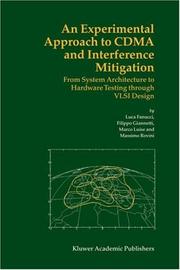
ISBN: 1402025378 1402077238 Year: 2004 Publisher: Boston, Massachusetts : Kluwer Academic,
Abstract | Keywords | Export | Availability | Bookmark
 Loading...
Loading...Choose an application
- Reference Manager
- EndNote
- RefWorks (Direct export to RefWorks)
An Experimental Approach to CDMA and Interference Mitigation was written with the admittedly ambitious intent of filling the gap between communication theory and VLSI implementation, and thus to provide a more general/theoretical approach to the design, development, and testing of a CDMA receiver. As a consequence, the concepts and techniques that are presented turn out to be applicable to a more general kind of digital wireless modems in terms of receiver architecture design and implementation. As the reader will easily find out, the subject of digital modem design and implementation is addressed in the book starting from a theoretical approach (supported by proper bibliographic references), and is followed by application issues, with reference to an ESA experiment assumed as a case study. A complete design flow, from specification to implementation, including testing and final verification is then presented. This leads the reader step-by-step to a thorough understanding of CDMA transmission and detection, and constitutes a practical guidance for the design of VLSI wireless mobile terminals.
Code division multiple access. --- Mobile communication systems --- Integrated circuits --- Radio circuits. --- Equipment and supplies. --- Very large scale integration. --- Telecommunication. --- Systems engineering. --- Computer engineering. --- Communications Engineering, Networks. --- Circuits and Systems. --- Electrical Engineering. --- Electrical engineering. --- Electronic circuits. --- Electron-tube circuits --- Electric circuits --- Electron tubes --- Electronics --- Electric engineering --- Engineering --- CDMA (Telecommunication) --- Spread spectrum multiple access --- Cell phone systems --- Multiplexing --- Spread spectrum communications --- Circuits, Radio --- Electronic circuits --- Very large scale integration of circuits --- VLSI circuits --- Vehicles --- Vehicular communication systems --- Radio --- Wireless communication systems --- Communication systems

ISBN: 3540011552 3662054310 3662054299 Year: 2004 Publisher: Berlin Springer
Abstract | Keywords | Export | Availability | Bookmark
 Loading...
Loading...Choose an application
- Reference Manager
- EndNote
- RefWorks (Direct export to RefWorks)
Digital Television deals with all present-day TV transmission methods, i.e. MPEG, DVB, ATSC and ISDB-T. The DVD Video is also discussed to some extent. The discussion is focussed on dealing with these subjects in as practical a way as possible. Although mathematical formulations are used, they are in most cases only utilized to supplement the text. The book also contains chapters dealing with basic concepts such as digital modulation or transformations into the frequency domain. A major emphasis is placed on the measuring techniques used on these various digital TV signals. Practical examples and hints concerning measurement are provided. The book starts with the analog TV baseband signal and then continues with the MPEG-2 data stream, digital video, digital audio and the compression methods. After an excursion into the digital modulation methods, all the mentioned transmission methods are discussed in detail. Interspersed between these are found the chapters on the relevant measuring technique.
digitale televisie --- MPEG --- DVD --- DVB --- ISDB-T --- Digital television. --- Digitale televisie --- Digitale televisie. --- Digital television --- Digital communications --- Digital media --- Television --- Electrical engineering. --- Microwaves. --- Optical engineering. --- Data structures (Computer science). --- Communications Engineering, Networks. --- Microwaves, RF and Optical Engineering. --- Electrical Engineering. --- Data Structures and Information Theory. --- Information structures (Computer science) --- Structures, Data (Computer science) --- Structures, Information (Computer science) --- Electronic data processing --- File organization (Computer science) --- Abstract data types (Computer science) --- Mechanical engineering --- Hertzian waves --- Electric waves --- Electromagnetic waves --- Geomagnetic micropulsations --- Radio waves --- Shortwave radio --- Electric engineering --- Engineering
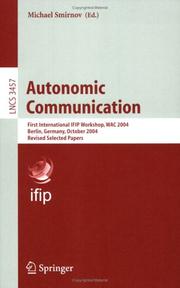
ISSN: 03029743 ISBN: 3540274170 9783540274179 3540320091 Year: 2004 Volume: 3457 Publisher: Berlin: Springer,
Abstract | Keywords | Export | Availability | Bookmark
 Loading...
Loading...Choose an application
- Reference Manager
- EndNote
- RefWorks (Direct export to RefWorks)
The ?rst IFIP Workshop on Autonomic Communication (WAC 2004) was held 18–19 October 2004 in Berlin, Germany. The workshop was organized by Fra- hofer FOKUS with the help of partners of the EU-funded Autonomic Com- nication Coordination Action — IST-6475 (ACCA), and under technical sp- sorship of IFIP WG6. 6 — Management of Networks and Distributed Systems. The purpose of this workshop was to discuss Autonomic Communication—a new communication paradigm to assist the design of the next-generation n- works. WAC 2004 was explicitly focused on the principles that help to achieve purposeful behavior on top of self-organization (self-management, self-healing, self-awareness, etc. ). The workshop intended to derive these common principles from submissions that study network element’s autonomic behavior exposed by innovative (cross-layer optimized, context-aware, and securely programmable) protocol stack (or its middleware emulations) in its interaction with numerous, often dynamic network groups and communities. The goals were to understand how autonomic behaviors are learned, in?uenced or changed, and how, in turn, these a?ect other elements, groups and the network. The highly interactive and exploratory nature of WAC 2004 de?ned its format — six main sessions grouped in three blocks, each block followed by a panel with all speakers of the previous block as panellists and session chairs as panel moderators. The?rstpanelaimedtohighlightthemainprinciplesguidingresearchinal- rithms,protocolsandmiddleware;thesecondpanelinvestigatedgrandchallenges of network and service composition; the third panel had to answer the question “HowDoestheAutonomicNetworkInteractwiththeKnowledgePlane?”. Panel reports were compiled by panel moderators and conclude this volume.
Computer communication systems. --- Application software. --- Information storage and retrieval. --- Electrical engineering. --- Computer Communication Networks. --- Information Systems Applications (incl. Internet). --- Information Storage and Retrieval. --- Communications Engineering, Networks. --- Electric engineering --- Engineering --- Application computer programs --- Application computer software --- Applications software --- Apps (Computer software) --- Computer software --- Communication systems, Computer --- Computer communication systems --- Data networks, Computer --- ECNs (Electronic communication networks) --- Electronic communication networks --- Networks, Computer --- Teleprocessing networks --- Data transmission systems --- Digital communications --- Electronic systems --- Information networks --- Telecommunication --- Cyberinfrastructure --- Electronic data processing --- Network computers --- Distributed processing --- Autonomic communication --- Autonomic computing --- Database management --- Computer networks
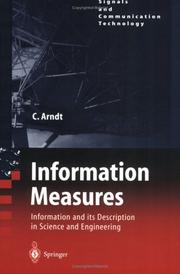
ISBN: 354040855X 3642566693 3540416331 9783540408550 Year: 2004 Publisher: Berlin: Springer,
Abstract | Keywords | Export | Availability | Bookmark
 Loading...
Loading...Choose an application
- Reference Manager
- EndNote
- RefWorks (Direct export to RefWorks)
This book is an introduction to the mathematical description of information in science and engineering. The necessary mathematical theory will be treated in a more vivid way than in the usual theorem-proof structure. This enables the reader to develop an idea of the connections between different information measures and to understand the trains of thoughts in their derivation. As there exist a great number of different possible ways to describe information, these measures are presented in a coherent manner. Some examples of the information measures examined are: Shannon information, applied in coding theory; Akaike information criterion, used in system identification to determine auto-regressive models and in neural networks to identify the number of neu-rons; and Cramer-Rao bound or Fisher information, describing the minimal variances achieved by unbiased estimators. This softcover edition addresses researchers and students in electrical engineering, particularly in control and communications, physics, and applied mathematics.
Information measurement --- Information measurement. --- Electrical engineering. --- Language and education. --- Applied mathematics. --- Engineering mathematics. --- Coding theory. --- Information theory. --- Statistical physics. --- Dynamical systems. --- Computational complexity. --- Communications Engineering, Networks. --- Language Education. --- Mathematical and Computational Engineering. --- Coding and Information Theory. --- Complex Systems. --- Complexity. --- Complexity, Computational --- Electronic data processing --- Machine theory --- Dynamical systems --- Kinetics --- Mathematics --- Mechanics, Analytic --- Force and energy --- Mechanics --- Physics --- Statics --- Mathematical statistics --- Communication theory --- Communication --- Cybernetics --- Data compression (Telecommunication) --- Digital electronics --- Information theory --- Signal theory (Telecommunication) --- Computer programming --- Engineering --- Engineering analysis --- Mathematical analysis --- Educational linguistics --- Education --- Language and languages --- Electric engineering --- Statistical methods
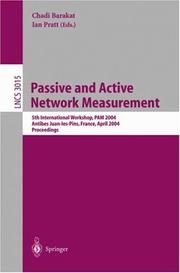
ISSN: 03029743 ISBN: 3540214925 9783540214922 9786610307319 1280307315 3540246681 Year: 2004 Volume: 3015 Publisher: Berlin, Heidelberg : Springer Berlin Heidelberg : Imprint: Springer,
Abstract | Keywords | Export | Availability | Bookmark
 Loading...
Loading...Choose an application
- Reference Manager
- EndNote
- RefWorks (Direct export to RefWorks)
PAM 2004 was the 5th International Workshop on Passive and Active Measu- ment,heldinJuan-les-PinsontheFrenchRiviera,co-organizedbytheUniversity ofCambridgeandINRIA-SophiaAntipolis,with?nancialsupportfromInteland Cisco Systems. This year we received a record number of submissions (184), re?ecting the growth of the ?eld and the critical role it plays in maintaining the network infrastructure on which we all rely. From the two-page abstracts submitted, the programme committee selected 29 papers whose authors were invited to submit full papers to appear in these proceedings. Particular emphasis was placed on selecting work that we felt was fresh and exciting, so as to encourage a dynamic and interactive workshop that provided a ?rst public presentation of research that will go on to appear in other, more formal conferences and journals. The programme committee was greatly impressed with the strength and depth of submissions received, which bodes well for the future of the subject area. This workshop took place during April 19–20, 2004 in Juan-les-Pins. Located betweentheAlpsandtheMediterranean,andclosetoNice,CannesandMonaco, Juan-les-Pins is one of the most beautiful sites on the French Riviera. Juan-les- Pins is also close to Sophia Antipolis, the French telecom valley. The workshop could not have succeeded without the support of many people whom we would like thank. First, we thank the members of the programme c- mittee for donating a considerable amount of time to review the unexpectedly large number of submissions, while working to a very tight deadline.
Computer networks --- Information networks --- Computer system performance. --- System Performance and Evaluation. --- Engineering. --- Computer communication systems. --- Computer system failures. --- Electrical engineering. --- Communications Engineering, Networks. --- Computer Communication Networks. --- Telecommunication. --- Electric communication --- Mass communication --- Telecom --- Telecommunication industry --- Telecommunications --- Communication --- Information theory --- Telecommuting --- Computer failures --- Computer malfunctions --- Computer systems --- Failure of computer systems --- System failures (Engineering) --- Fault-tolerant computing --- Communication systems, Computer --- Computer communication systems --- Data networks, Computer --- ECNs (Electronic communication networks) --- Electronic communication networks --- Networks, Computer --- Teleprocessing networks --- Data transmission systems --- Digital communications --- Electronic systems --- Telecommunication --- Cyberinfrastructure --- Electronic data processing --- Network computers --- Electric engineering --- Engineering --- Failures --- Distributed processing --- Computer networks - Congresses --- Information networks - Congresses --- Computer networks.
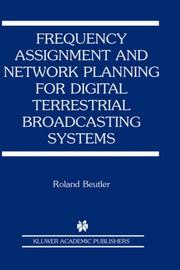
ISBN: 1280609524 9786610609529 1402078730 1402078722 1475788576 Year: 2004 Publisher: New York : Kluwer Academic Publishers,
Abstract | Keywords | Export | Availability | Bookmark
 Loading...
Loading...Choose an application
- Reference Manager
- EndNote
- RefWorks (Direct export to RefWorks)
Frequency Assignment and Network Planning for Digital Terrestrial Broadcasting Systems focuses on Digital Audio Broadcasting and Digital Video Broadcasting. The author provides a concise introduction to the subject and presents principles, concepts and commonly accepted methods used in the planning process. The frequency assignment material focuses on allotment planning while network planning is dealt with mainly from a network optimization perspective. All methods introduced and mathematical tools presented are fully explained. General concepts are illustrated with the help of several planning scenarios both for frequency assignment and network planning. Frequency assignment and network planning are vital issues throughout most of Europe and North America as a direct consequence of the increasing demand for digital communication systems.
Industries. --- Electrical engineering. --- Computer communication systems. --- Science, Humanities and Social Sciences, multidisciplinary. --- Communications Engineering, Networks. --- Electrical Engineering. --- Computer Communication Networks. --- Digital television. --- Digital audio broadcasting. --- Digital communications. --- Communication systems, Computer --- Computer communication systems --- Data networks, Computer --- ECNs (Electronic communication networks) --- Electronic communication networks --- Networks, Computer --- Teleprocessing networks --- Data transmission systems --- Digital communications --- Electronic systems --- Information networks --- Telecommunication --- Cyberinfrastructure --- Electronic data processing --- Network computers --- Electric engineering --- Engineering --- Industrial production --- Industry --- Economics --- Distributed processing --- Communications, Digital --- Digital transmission --- Pulse communication --- Digital electronics --- Pulse techniques (Electronics) --- Digital media --- Signal processing --- Broadcasting, Digital audio --- DAB (Broadcasting) --- Digital radio transmission --- Television --- Digital techniques

ISBN: 128046223X 9780306484897 9786610462230 0306484897 1402077289 6610462232 9780306484896 9781280462238 Year: 2004 Publisher: Boston : Kluwer Academic Publishers,
Abstract | Keywords | Export | Availability | Bookmark
 Loading...
Loading...Choose an application
- Reference Manager
- EndNote
- RefWorks (Direct export to RefWorks)
Project Management for Telecommunications Managers is a concise reference work covering important aspects of project management. It explains many key concepts, in layman's terms, for engineering managers, project managers and other professionals working in the telecommunications environment. This presentation is consistent with many of the processes recommended by the certification body for project managers, the Project Management Institute; however, the material expands on the guide by elaborating on the application of the processes in telecommunications projects. The book covers concepts and applications applicable to all telecommunications related areas. Tools for planning, organizing, tracking and managing projects are provided. The author has also included actual examples of various telecommunications projects from wireline and wireless providers, equipment vendors and component manufacturers to illustrate concepts. Important information for working across departmental and functional units and various organizational structures are also included. This book is highly recommended for project managers and project team members who work on projects in the telecommunications environment.
Telecommunication --- Project management --- Business & Economics --- Transportation Economics --- Management --- Project management. --- Electrical engineering. --- Electronics. --- Microelectronics. --- Management. --- Industrial management. --- Information technology. --- Business—Data processing. --- Project Management. --- Communications Engineering, Networks. --- Electronics and Microelectronics, Instrumentation. --- Electrical Engineering. --- Innovation/Technology Management. --- IT in Business. --- IT (Information technology) --- Technology --- Telematics --- Information superhighway --- Knowledge management --- Business administration --- Business enterprises --- Business management --- Corporate management --- Corporations --- Industrial administration --- Management, Industrial --- Rationalization of industry --- Scientific management --- Business --- Industrial organization --- Administration --- Industrial relations --- Organization --- Microminiature electronic equipment --- Microminiaturization (Electronics) --- Electronics --- Microtechnology --- Semiconductors --- Miniature electronic equipment --- Electrical engineering --- Physical sciences --- Electric engineering --- Engineering --- Industrial project management

ISBN: 1280306696 9783540246061 9786610306695 3540246061 3540208259 Year: 2004 Publisher: Berlin, Heidelberg : Springer Berlin Heidelberg : Imprint: Springer,
Abstract | Keywords | Export | Availability | Bookmark
 Loading...
Loading...Choose an application
- Reference Manager
- EndNote
- RefWorks (Direct export to RefWorks)
WithgreatpleasurewewelcomedtheattendeestoEWSN2004,the1stEuropean Workshop on Wireless Sensor Networks, held in the exciting and lively city of Berlin. Wireless sensor networks are a key technology for new ways of interaction betweencomputersandthephysicalenvironmentwhichsurroundsus.Compared to traditional networking technologies, wireless sensor networks are faced with a rather unique mix of challenges: scalability, energy e?ciency, self-con?guration, constrainedcomputationandmemoryresourcesinindividualnodes,data-cent- city, and interaction with the physical environment, to name but a few. The goal of this workshop is to create a forum for presenting new results in the ?ourishing ?eld of wireless sensor networks. By bringing together academia and industry we hope to stimulate new opportunities for collaborations. In compiling the scienti?c program we have been quite selective. Thanks to the e?orts of 90 reviewers who delivered 252 reviews for the 76 papers originally submitted from all over the world, a strong selection of the 24 best contributions was made possible. The Technical Program Committee created an outstanding program covering the broad scope of this highly interdisciplinary ?eld: from distributed signal processing through networking and middleware issues to - plication experience. Running such a workshop requires dedication and much work from many people. We want to thank in particular Petra Hutt, Irene Ostertag and Heike Klemz for their valuable and esteemed help in the local organization of this workshop. We hope that you enjoy this volume, and if you were lucky enough to - tend we hope that you enjoyed the discussions with colleagues working in this fascinating area.
Computer science. --- Computer Communication Networks. --- Software engineering. --- Computer software. --- Information systems. --- Computer Science. --- Algorithm Analysis and Problem Complexity. --- Programming Techniques. --- Software Engineering. --- Information Systems Applications (incl.Internet). --- Special Purpose and Application-Based Systems. --- Sensor networks --- Electrical Engineering --- Electrical & Computer Engineering --- Engineering & Applied Sciences --- Engineering. --- Computer communication systems. --- Computer programming. --- Algorithms. --- Electrical engineering. --- Communications Engineering, Networks. --- Information Systems Applications (incl. Internet). --- Telecommunication. --- Computer software engineering --- Engineering --- Informatics --- Science --- Software, Computer --- Computer systems --- Electric communication --- Mass communication --- Telecom --- Telecommunication industry --- Telecommunications --- Communication --- Information theory --- Telecommuting --- Application software. --- Application computer programs --- Application computer software --- Applications software --- Apps (Computer software) --- Computer software --- Computers --- Electronic computer programming --- Electronic data processing --- Electronic digital computers --- Programming (Electronic computers) --- Coding theory --- Algorism --- Algebra --- Arithmetic --- Communication systems, Computer --- Computer communication systems --- Data networks, Computer --- ECNs (Electronic communication networks) --- Electronic communication networks --- Networks, Computer --- Teleprocessing networks --- Data transmission systems --- Digital communications --- Electronic systems --- Information networks --- Telecommunication --- Cyberinfrastructure --- Network computers --- Electric engineering --- Programming --- Foundations --- Distributed processing --- Computer networks.
| Listing 1 - 10 of 32 | << page >> |
Sort by
|

 Search
Search Feedback
Feedback About UniCat
About UniCat  Help
Help News
News